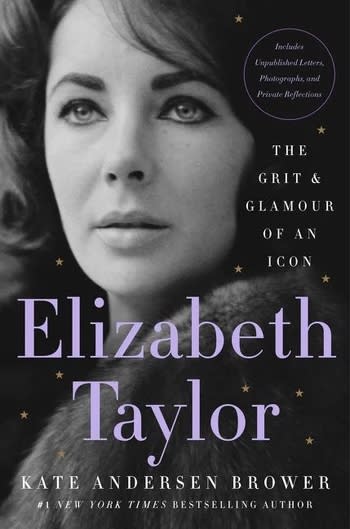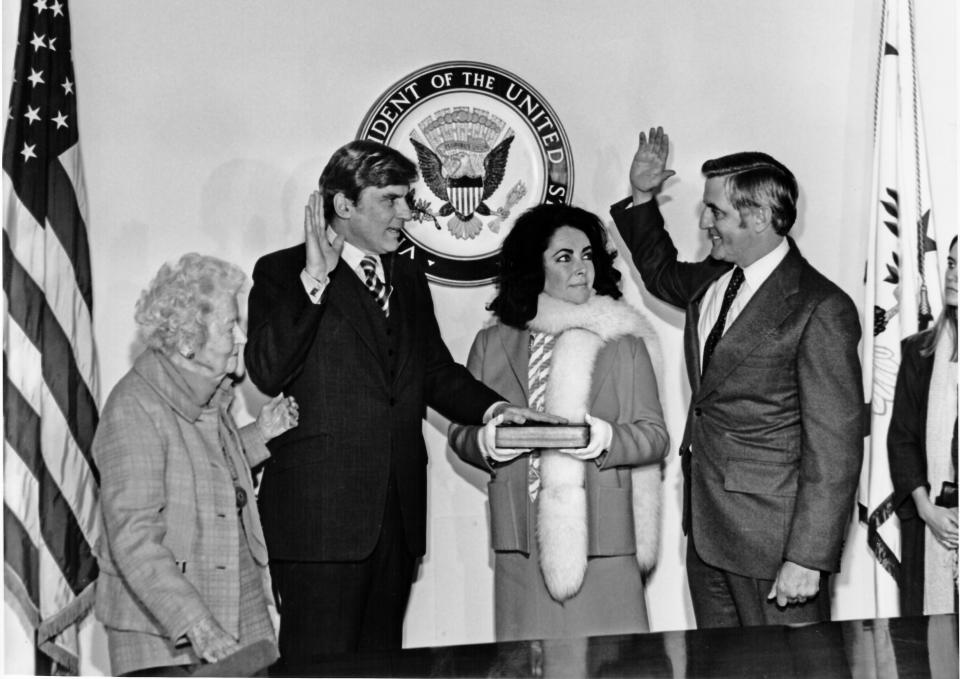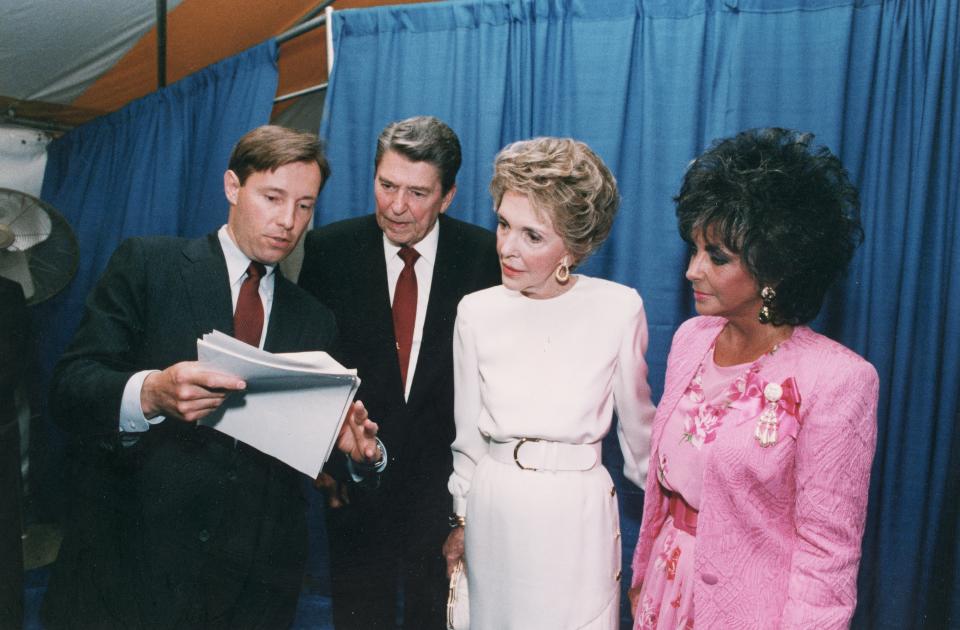Authorized Biography Shows How Elizabeth Taylor’s Years In D.C. And Alarm Over The AIDS Crisis Led Her To Redefine Celebrity Activism
- Oops!Something went wrong.Please try again later.

Kate Andersen Brower’s Elizabeth Taylor: The Grit and Glamour of An Icon is billed as the first-ever authorized biography of the legendary actress, as her family and estate gave her access to Taylor’s private letters, photos and diaries.
What Brower found was new insight into Taylor’s later-in-life emergence as an influential activist, using her star power to help push forward legislation to address HIV and AIDS and, well ahead of much of the industry, her fame to raise money to combat the epidemic and assist patients.
More from Deadline
Douglas Kirkland Dies: Iconic Photographer Of Celebrities, Film Shoots Was 88
Serinda Swan To Play Elizabeth Taylor In Black Label Media's Korean War Pic 'Devotion'
The book is a bit of a departure for Brower, the author of The Residence, First Women, Team of Five and First in Line, all focused on the White House and the presidency. The Taylor biography grew out of conversations she had with John Warner, the former senator who was married to Taylor from 1976 to 1982, before he died last year. She originally wanted to write about “really just the first influencer of her time” but, after Warner put her in touch with Taylor’s children, the book expanded into a full-scale biography.

The book also details Taylor’s struggles and vulnerabilities, including her battle with addiction, but also shows how a particularly unhappy period of her life, her time as a “political wife” with Warner in Washington, actually helped her learn about political power for her future activism.
Deadline spoke to Brower about what most surprised her about Taylor, more than a decade after her death.
DEADLINE: You have said that the book started with John Warner, who was one of Elizabeth Taylor’s husbands, who put you in touch with her children. Were they looking at the time for someone to do an authorized biography of their mother and grandmother?
KATE ANDERSEN BROWER: They were interested in having her story told to a younger generation. And so it kind of worked out well because I originally wanted to just focus on our AIDS activism because I thought, ‘Now we look at celebrities as influencers and activists, but it was really Elizabeth who was at the starting point and really changed the kind of incredible power that celebrities now have.’ … And then it was her trustees and children who came to me and said, ‘Well, what about writing a biography for entire life?’ And I thought at first that seemed very overwhelming because her life was so huge. But it was hard to pass up that chance.
DEADLINE: You got access to her archive, letters and diary entries. What surprised you most in reading through them?
BROWER: She was so multifaceted. For me, I always kind of saw this very strong woman. I didn’t realize how vulnerable she was, especially in her letters to Richard Burton where she was pleading with him to get married a second time, and asking him to stop showering her with presents and [to just be] there for her. And just the kind of ways that she had to deal with Senator Warner too. She wanted to take out an ad for gun control in The New York Times… after [Ronald] Reagan was almost assassinated, and she said, ‘This is really important to me, I’m going to do it.’ And Warner, a Republican, said in these letters to her, ‘Honey, you know, I don’t think it’s the best idea. Why don’t you wait? It could backfire and what if we end up hurting other people?’ He just is really pushing her not to do it. And she does it anyway. So it’s kind of great to see the fight that she had to kind of keep going. It looks like she lived such a charmed life, but even she even she had to do a lot to survive.
DEADLINE: There’s an irony in that John Warner is the one who connected you with with her family, but that period where she was married to him wasn’t particularly happy for her.
BROWER: That period of her life was so traumatic in Washington. She said it turned her into a drunk and and junkie. She hated being being here and away from L.A., and just being a supporting actor. I think she was not comfortable in that position at all. But it would have been disingenuous not to dedicate [the book] to [Warner] because he is the reason why it came to be. He loved her until he passed away. He would call me and say ‘When is the book going to be done? I don’t have much longer.’ He wanted to see it out in the world. … Not that she would ever be forgotten, but I think that … major celebrities get kind of made into one dimensional figures and she was so complicated and interesting. She wasn’t Marilyn Monroe. She was no one’s victim.

DEADLINE: That period when she was in Washington, I think she said she was kind of treated like a freak.
BROWER: The important thing about that marriage is that it later made her into the activist she was. She sort of knew how to manipulate the levers of power. When she was becoming an AIDS activist and she would come to D.C., she would give these old senators, mostly older white men, lavender-scented stationery with personal notes, and they would take it out on the floor of the Senate and show it off to each other. But it was all just to get money for AIDS.
I think she she realized the power she had. She helped Warner get elected. But ridiculous things were said to her. There was a lot of a lot of crazy fat-shaming at the time with the idea that she gained 40 pounds. There are some interviews with her from that period in the 70s and they’re just so insensitive, asking, ‘Why have you gotten so heavy?’ And she was eating too much. She was drinking too much because she was lonely. And I think when she married John Warner, she thought she was going to be a political partner, and she was going to be a part of his his office and his decision making. And instead, once he got elected, he just told her to go home, either to their Georgetown house or to their farm in Middleburg and ride horses. And that wasn’t Elizabeth Taylor. She needed to be active.
DEADLINE: There’s a great anecdote you have about how she did have some influence at one point. She was traveling with Warner in Virginia and was upset at not being able to use a public restroom because they asked for a dime to use it and she didn’t have one. And that led to legislation to ban the use of pay toilets.
BROWER: Warner was just laughing so hard recounting that story. And it was so fun to talk to him because I would go to his house in Alexandria and his current wife Jeanne, the woman he married after Elizabeth, who was a real estate agent and a lovely woman, would be sitting there with us, and I always joked with her about how odd it must be to sit there and listen to him talk about his marriage to the most glamorous movie star of the 20th century. But she was amazing. And sometimes with Warner too, he would downplay the problems they had. He would say things like, ‘Elizabeth really didn’t drink too much. That wasn’t fair.’ And Jeanne, his wife. would kind of elbow him and say, ‘John, come on. She drank a lot.’ Kind of keeping it real. Because he did want to paint a rosier picture of their time, understandably, because he did care about her and when they parted ways, it was amicable. But he was trying to turn her into something she wasn’t. His aides would ask her to wear more tweed and darker colors and no more purple, and it was ridiculous. She said, ‘Why no purple?’ And they said. ‘It connotes passion’. And she said ‘What’s wrong with passion?’ It’s that Washington stiff control of the wife at the time that I think she bristled at.
DEADLINE: That control that kind of kept her from speaking out on gay rights in the late 70s, when there was an effort to ban gay teachers.
BROWER: She wanted to speak out, but these letters between her and her publicist were really revealing. It was Anita Bryant at the time [working against gay rights]. Her publicist said, ‘I know you normally really want to get involved and but I recommend that you don’t.’ And in the 1980s, there is this great speech that she gives at the National Press Club where she says, ‘nobody else is doing anything. I wasn’t doing anything. And I looked in the mirror and said, ‘Bitch do something.’ And she was really outspoken about gay marriage at a time when people weren’t seriously talking about it.
It was mostly gay men because she had so many great relationships with gay men throughout her life, but it was just people who were being treated unfairly, as she was always an outsider herself, and she thought of herself that way. She paid for dentures for a woman in the Lower East Side needle exchange, who was toothless, and she said, ‘You’re never going to be able to get a job if you don’t have teeth.’ And she went ahead and bought her a new set of teeth. She did things like that.
DEADLINE: There was this misperception that her work on AIDS and HIV was started that because of her friend Rock Hudson. But you point out how she got involved before she learned of his diagnosis.
BROWER: It was before that, and I had endless conversations with her trustees or her assistant Tim Mendelson, who is wonderful and worked for her for 20 years. You know, it’s baffling. There isn’t this one moment, I wish there was, that is the reason why she got involved, but there are so many little moments. Her daughter in law, Aileen Getty, from the Getty family, is HIV positive. So she’s the mother of two of Elizabeth’s grandchildren. Elizabeth’s assistant Roger Wall was HIV positive and actually later he committed suicide. So she had a lot of firsthand experience with AIDS and suffering in general.
DEADLINE: You have the anecdote about her visiting Rock Hudson in his final weeks and she got right into bed with him and hugged him. This was at a time when there was such a stigma around AIDS.
BROWER: There were all these born-again Christians at his house in L.A., and she was there visiting. and they were all kind of sort of standing by his bedside awkwardly, and she was just like, ‘This is ridiculous,’ and jumped into bed with him and cuddled up with him. She was always about that human touch, kind of like Princess Di. She knew how important it was to hold people. When she would go to AIDS hospices, she also did an amazing thing that is monetizing the commodity of Elizabeth Taylor. She would go on her perfume tours in the 90s for White Diamonds, and every city she visited, she would go to a hospice with no press, and then she would have a department store and the perfume company match the donation that she would give to that hospice. So she was so calculating, and so smart and how she was using her celebrity at a time when people weren’t really doing it that much.
DEADLINE: Her visits to the hospices didn’t get publicized. How much did you how did you learn about a lot the extent to which she would go meet patients.
BROWER: I just called those hospices that I knew she had visited because the trustees told me she had, and I talked to some nurses who remembered the visits, and they would tear up just remembering it decades later, because it it meant a lot to them that she cared. One of the patients woke up and said, ‘I had a dream that Elizabeth Taylor came to me,’ and they said, ‘She did. She was here.’ And I love that she would get dressed up and she would have the Krupp Diamond and hair and makeup. She wanted these men, who were dying and had no real treatments, to feel like they met a movie star. And I just think the way she separated herself from this commodity that was created for her when she was 12, was really shrewd and revolutionary.

DEADLINE: Would how influential do you think she was in getting Ronald Reagan to talk about AIDS?
BROWER: I think it would have taken even longer if she hadn’t been there, because she visited him in the Oval Office and she flirted with him. She certainly used her charm and got him to go to the Potomac dinner [an AIDS fundraiser]. This is ’87, and the first cases were reported in ’81. So this was a long time, and she was furious. And there are these letters where she’s begging Nancy Reagan to come to events to help, and Nancy Reagan’s response would often be, ‘You know, we can’t do them all. We can’t do everything, but good luck.’ [Taylor] just finally wore [Ronald Reagan] down. And then she was really smart because at the Potomac dinner, he was not as empathetic and it wasn’t supporting gay men with AIDS. It was still judgmental that speech, and he was booed. And afterwards she defended him and said, ‘You know, it’s really important that he came.’ And I think she did that knowing that you have to kind of butter people up to get what you want.
DEADLINE: You have an anecdote from the early 1990s of her visiting Capitol Hill as she was lobbying for passage of the Ryan White Care Act. She knew lawmakers would want their picture taken with her, but the condition was they had to co-sponsor the bill to do so.
BROWER: Yeah, it was her and Jeanne White-Ginder, Ryan’s mother, kind of working as a team to get that passed. It wouldn’t have happened, because they both complemented each other in really important ways, Jeanne in such a personal way and Elizabeth as a star. … She wasn’t just going to be used for a photo op. She needed something in return. That was always it. It was transactional for her. … There was an understanding of her value, and if it was a fundraiser for a million or more, she was happy to go, but if it was something someone else could do, she didn’t think she needed to be there. She knew her value at a time when I think a lot of women undervalued themselves.
DEADLINE: Where do you think her compassion comes from?
BROWER: I think she had a lot of pain. There was a story that her assistant Tim Mendelson told me where they had a shaman come…. and did a healing ritual and where she put her hands above Elizabeth’s body. This is in the 90s. And when she went to the bathroom afterward, Tim said the shaman was very upset. She said, ‘I have never, ever seen a woman holding so much pain.’ I mean, she just she lived a life that was full of tragedy. When she was 26 she had been twice divorced, once widowed, doing ‘Cat on a Hot Tin Roof’ having to support her family. Mike Todd, one of the great loves of her life dies in a plane crash after a year of marriage. She lost a lot of people in her life. And I think that makes you empathetic. She was in a lot of pain herself. She had a back pain throughout her life too. So she gravitated towards other people in pain.
DEADLINE: Did one another thing that I thought was was really interesting that her granddaughter told you that that she liked traditional roles in her personal life but that was not how she lived.
BROWER: That’s right. In her personal life, she wanted to be Mrs. John Warner. She saw marriage as a way of escape. It was really a way of escaping ‘Elizabeth Taylor.’ It was becoming someone’s wife. But in her acting choices, she did these films that were really groundbreaking. Suddenly Last Summer. A Place in the Sun, which touches on abortion, and Giant about immigration. Her artistic choices were really bold, but her life choices were very, strangely kind of puritanical. Even though she was married so many times, she said if she slept with a man she would have to marry him.
Best of Deadline
2022-23 Awards Season Calendar - Dates For The Oscars, Golden Globes, Guilds & More
Red Sea International Film Festival 2022: Best Of The Red Carpet Gallery
Sign up for Deadline's Newsletter. For the latest news, follow us on Facebook, Twitter, and Instagram.

